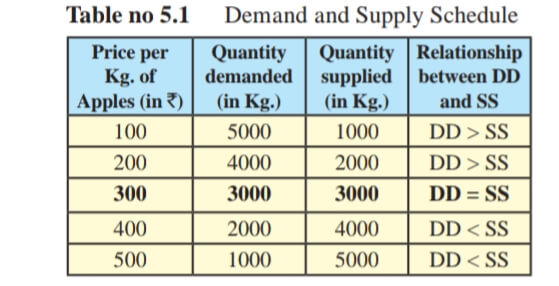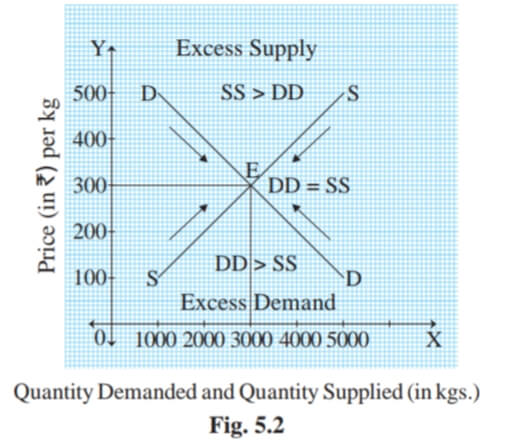Chapter 5 forms of market class 12 Maharashtra Board
Chapter 5 forms of market class 12 Maharashtra Board
Perfect Competition :
Perfect competition is a market situation where there is a large number of buyers and sellers buying and selling homogeneous products at a single uniform price. It refers to market conditions which include the following features.
- Large number of buyers and sellers: – In perfect competition, there is a large number of buyers and sellers. Their number is so large, that single buyers and sellers cannot affect the market demand and supply.
- Homogeneous product: – The product supplied by all the sellers is homogeneous or identical (same, similar) in all respects. That is size, colure, shape, quantity, etc.
- Free entry and exit: – In a perfect competition market, there is complete freedom for entry and exit of buyers and sellers. Any buyer or seller enters the market or exits from the market as and he wants.
- Single price: A single uniform price prevails under perfect competition which is determined by the interaction of demand and supply.
- Perfect knowledge about market: – Every buyer should have perfect knowledge about the market conditions like price, quality, quantity, and features of the product. If buyers have perfect knowledge about the market condition they cannot be charged more by the seller.
- Perfect mobility of factors of production: – labour, capital, etc. are known as features of the production. They are freely movable from one industry to another or one market area to another.
- Absence of transport cost: – In perfect competition, the transport cost remains the same or equal to another firm. If the transport cost is included in the cost, it makes a lot of difference in the price of the same commodity.
- No government intervention: – It assumes that the government does not interfere in respect of the production, transportation, and exchange of goods. In other words, there are no government restrictions.
- Demand curve of the firm: – Under perfect competition demand curve is perfectly elastic i.e. a horizontal straight line parallel to the X-axis because the seller can sell an infinite quantity at market price.
Price determination under Perfect Competition:
- The interaction of demand and supply determines the price of the commodity in perfect competition. This is known as ‘equilibrium price.’ The equilibrium price is the price at which the quantity demanded is equal to the quantity supplied.
- The price of the product under perfect competition is influenced by both buyers and sellers and the equilibrium price is determined by the interaction of demand and supply forces.
- This is explained with the help of the following schedule and diagram.

- When the price rises from 100 to 200 quantity demanded falls from 5000 kgs. to 4000 kgs. whereas supply increases from 1000 kgs. to 2000 kgs. This is because demand falls with rising in price and supply rises with a rise in price. This is the stage where demand is greater than supply (DD >SS).
- When the price rises to 300, the quantity demanded and quantity supplied become equal that is 3000 kg. This is the stage of equilibrium where demand and supply become equal (DD = SS). Hence, 300 becomes the equilibrium price.
- When price further rises from 400 to 500, demand falls from 2000 kgs. to 1000 and supply rises from 4000 kgs. to 5000 kgs. Thus, supply is greater than demand. (SS > DD).
The process of price determination is explained in the following figure 5.2.
- In the above diagram, the X-axis represents the quantity demanded and quantity supplied, whereas Y-axis represents the price.
- DD is the downward sloping demand curve which shows the inverse relationship between price and quantity demanded.
- SS is the upward-sloping supply curve which shows a direct relationship between price and quantity supplied.
- E is the equilibrium point where DD and SS curves intersect each other.
- Accordingly, 300 is the equilibrium price, and 3000 kgs. is the equilibrium quantity demanded and supplied. This equilibrium price is determined by market demand and market supply.
Monopoly :
The term ‘monopoly’ is derived from two Greek words ‘mono’ which means ‘one’ and ‘poly’ which means ‘seller’. A monopoly is a market situation where there is only one seller who commands complete control over the supply of commodities. There is no competition in the market, and therefore, the seller is a price maker and not a price taker.
The following are the features of a monopoly:
- Single seller: A monopoly is a market situation in which there is only one seller controlling the entire supply of a commodity in the market. There is no competition from the seller’s side.
- No Close Substitute: – The commodity supplied or sold by the monopolist has no substitute. Therefore the buyers have no choice, but to buy the product, or go without it.
- Barriers to entry: – Under the monopoly situation there are entry barriers to other firms. The seller may have exclusive marketing rights to market the product in a particular area or country for a certain period. Thus, other producers are not allowed to enter the market.
- Complete control over the market supply: The monopolist has a complete hold over the market. He is the sole producer or seller of the product.
- Price maker: – In Monopoly the seller is a “price maker” since the monopolist has entire control of supply in the market. Therefore he can determine the market price. The seller under monopoly can be called a price maker.
- Price discrimination: When a firm charges different prices to different buyers for the same product, it is called a discriminating monopoly.
- No difference between firm and industry: – Under monopoly, there is only one producer. Since he is the sole producer of a product, there is no difference between firm and industry. The firm itself becomes the industry for that type of product.
- Large number of buyers: – under monopoly, there are large numbers of buyers in the market; who compete with one another.
- No competition: – Under monopoly there is only one seller of a product without having close substitutes, there is no competition in the market. In other words, the seller enjoys a monopoly.
- Demand curve: The demand curve in the case of a monopoly market is downward sloping. This indicates that though he is a price maker If he wants to increase the sales he must sell at a lower price.
Types of monopoly
- Private Monopoly: – When an individual or private firm owns and controls the production of goods, it is regarded as a private monopoly. For example, Tata Group.
- Public Monopoly: – when the government owns and controls the production of goods, it is called a public monopoly. For example, Indian Railways.
- Legal monopoly: This monopoly emerges on account of legal provisions like patents, trademarks, copyrights, etc. The law forbids potential competitors to imitate the design or form of the product registered under given branded names. For example, Amul products.
- Natural Monopoly: – When a firm acquires power due to natural advantages such as location, and climate conditions, it is called a natural monopoly. For example, wheat from Punjab.
- Simple Monopoly: – When a firm charges the same price to a different buyer for the same product, it is called a simple monopoly.
- Discriminating Monopoly: – When a firm charges a different price to different buyers for the same product, it is called a discriminating monopoly.
- Voluntary monopoly: To avoid cut-throat competition, some monopolists voluntarily come together and form a group of monopolists. This facilitates them to maximize profit. For example, the Organisation of Petroleum Exporting Countries (OPEC).
Oligopoly :
The term oligopoly is derived from the Greek words ‘Oligo’ which means few and ‘poly’ which means sellers. It is a market where there are a few firms (sellers) in the market producing either a homogeneous product or a differentiated product. For example, mobile service providers, cement companies, etc.
Features of oligopoly :
- Few firms or sellers: Under an oligopoly market, there are few firms or sellers. These few firms dominate the market and enjoy considerable control over the price of a product.
- Interdependence: There are few sellers in the market, if any firm makes a change in the price, all other firms in the industry also try to follow the same to remain in the competition. Therefore, the seller has to be cautious with respect to any action taken by the competing firms.
- Advertising: Advertising is a powerful instrument in the hands of oligopolists. A firm under an oligopoly can start an aggressive and attractive advertising campaign with the intention of capturing a large part of the market.
- Entry barriers: The firm can easily exit from the industry whenever it wants. But has to face certain entry barriers such as Government licenses, patents, etc.
- Lack of uniformity: There is a lack of similarity among the firms in terms of their size. Some firms may be small while others may be of a bigger size.
- Uncertainty: There is a considerable element of uncertainty in this type of market due to different behaviour patterns. Rivals may join hands and cooperate or may try to fight each other.
Monopolistic competition :
Monopolistic competition is a type of market in which there are a large number of firms that produce and sell similar but that are differentiated but close substitutes to each other. The monopolistic competition exists between the sellers of differentiated products. Monopolistic competition is a mixture of the features of competition and monopoly. Monopolistic competition exists in the case of products like toothpaste, soaps, etc., and consumer durable like TV sets and refrigerators, etc.
The following are the features of monopolistic competition.
- Fairly large number of sellers: – In a monopolistic competition market, there is a large number of sellers. Hence, a single seller cannot influence the market supply.
- Fairly Large number of buyers: – In monopolistic competition, there is a large number of buyers who purchase goods by choice, not by chance. So to attract more customers, the seller introduces the product according to the taste, and preference of the customer.
- Product differentiation: – Product differentiation in terms of colour, size, design, taste, etc. Product differentiation can also take place in the form of brand names and trademarks. Product differentiation gave rise to the element of monopoly.
- Free entry and exit: – There are free entry and exit of firms under a monopolistic competition market. There are no barriers for the firm to enter or exit. A firm can easily enter the market with a product that is a close substitute to another firm’s product.
- Selling Cost: Selling costs are peculiar to monopolistic competition only. It refers to the cost incurred by the firm to create more demand for its product and thus increase the volume of sales. It includes expenditure on advertisements, radio and television broadcasts, hoardings, exhibitions, window displays, free gifts, free samples, etc.
- Close substitute: – The product is differentiated but still close substitutes of each other. E.g. we have different brands of soaps in the market.
- Price maker: – In monopolistic competition, the firm is a price maker. The firm has some control over the price due to product differentiation. Thus, there is price differentiation between the firms producing close substitutes.
For Other Subjects Click Here
Reference: MHSB books

